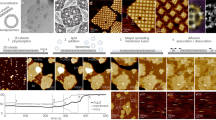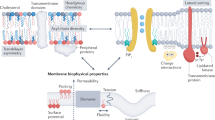Abstract
Thanks largely to a cooperative chelate effect, clustered membrane-embedded proteins favourably bind to multivalent ligands in solution and, conversely, a multivalent receptor can induce the clustering of membrane-embedded proteins. Here, we use a chemical model to show that the binding of a monovalent ligand and the clustering of a membrane-embedded receptor are closely related processes that modulate each other without the contribution of any apparent multivalence effect. Clearly, the confinement of the receptor within the surface reveals cooperative effects between clustering and binding that are too weak to detect in bulk-solution systems. This work shows that for membrane-embedded receptors that undergo some degree of spontaneous clustering, analyses based on multivalence-mediated cooperativity are insufficient to describe fully the molecular recognition events induced by ligands in solution. Instead, a binding–clustering thermodynamic cycle is proposed for the analysis of the interaction of any kind of ligand with membrane-embedded receptors.
This is a preview of subscription content, access via your institution
Access options
Subscribe to this journal
Receive 12 print issues and online access
$259.00 per year
only $21.58 per issue
Buy this article
- Purchase on Springer Link
- Instant access to full article PDF
Prices may be subject to local taxes which are calculated during checkout




Similar content being viewed by others
References
Luckey, M. Membrane Structural Biology (Cambridge Univ. Press, 2008).
Grakoui, A. et al. The immunological synapse: a molecular machine controlling T cell activation. Science 285, 221–227 (1999).
Renner, M., Specht, C. G. & Triller, A. Molecular dynamics of postsynaptic receptors and scaffold proteins. Curr. Opin. Neurobiol. 18, 532–540 (2008).
Simons, K. & Toomre, D. Lipid rafts and signal transduction. Nature Rev. Mol. Cell Biol. 1, 31–39 (2000).
Allen, J. A., Halverson-Tamboli, R. A. & Rasenick, M. M. Lipid raft microdomains and neurotransmitter signaling. Nature Rev. Neurosci. 8, 128–140 (2007).
Tolar, P., Hanna, J., Krueger, P. D. & Pierce, S. K. The constant region of the membrane immunoglobulin mediates B cell-receptor clustering and signaling in response to membrane antigens. Immunity 30, 44–55 (2009).
Munoz, P. et al. Antigen-induced clustering of surface CD38 and recruitment of intracellular CD38 to the immunologic synapse. Blood 111, 3653–3664 (2008).
Chichili, G. R. & Rodgers, W. Clustering of membrane raft proteins by the actin cytoskeleton. J. Biol. Chem. 282, 36682–36691 (2007).
Wang, H. B., Bedford, F. K., Brandon, N. J., Moss, S. J. & Olsen, R. W. GABA(A)-receptor-associated protein links GABA(A) receptors and the cytoskeleton. Nature 397, 69–72 (1999).
Oshovsky, G. V., Reinhoudt, D. N. & Verboom, W. Supramolecular chemistry in water. Angew. Chem. Int. Ed. 46, 2366–2393 (2007).
Cockroft, S. L. & Hunter, C. A. Chemical double-mutant cycles: dissecting non-covalent interactions. Chem. Soc. Rev. 36, 172–188 (2007).
Voskuhl, J. & Ravoo, B. J. Molecular recognition of bilayer vesicles. Chem. Soc. Rev. 38, 495–505 (2009).
Zhang, J. B., Cao, H. H., Jing, B. W., Almeida, P. F. & Regen, S. L. Cholesterol–phospholipid association in fluid bilayers: a thermodynamic analysis from nearest-neighbor recognition measurements. Biophys. J. 91, 1402–1406 (2006).
Regen, S. L. Lipid–lipid recognition in fluid bilayers: solving the cholesterol mystery. Curr. Opin. Chem. Biol. 6, 729–735 (2002).
Doyle, E. L., Hunter, C. A., Phillips, H. C., Webb, S. J. & Williams, N. H. J. Am. Chem. Soc. 125, 4593–4599 (2003).
Jiang, H. & Smith, B. D. Dynamic molecular recognition on the surface of vesicle membranes. Chem. Commun. 1407–1409 (2006).
Thomas, G. B. et al. Carbohydrate modified catanionic vesicles: probing multivalent binding at the bilayer interface. J. Am. Chem. Soc. 131, 5471–5477 (2009).
Gong, Y., Ma, M., Luo, Y. & Bong, D. Functional determinants of a synthetic vesicle fusion system. J. Am. Chem. Soc. 130, 6196–6205 (2008).
Richard, A. et al. Fusogenic supramolecular vesicle systems induced by metal ion binding to amphiphilic ligands. Proc. Natl Acad. Sci. USA 101, 15279–15284 (2004).
Menger, F. M., Seredyuk, V. A. & Yaroslavov, A. A. Adhesive and anti-adhesive agents in giant vesicles. Angew. Chem. Int. Ed. 41, 1350–1352 (2002).
Mart, R. J., Liem, K. P., Wang, X. & Webb, S. J. The effect of receptor clustering on vesicle–vesicle adhesion. J. Am. Chem. Soc. 128, 14462–14463 (2006).
Mansfeld, F. M., Feng, G. Q. & Otto, S. Photo-induced molecular-recognition-mediated adhesion of giant vesicles. Org. Biomol. Chem. 7, 4289–4295 (2009).
Sanchez-Quesada, J., Isler, M. P. & Ghadiri, M. R. Modulating ion channel properties of transmembrane peptide nanotubes through heteromeric supramolecular assemblies. J. Am. Chem. Soc. 124, 10004–10005 (2002).
Litvinchuk, S. et al. Synthetic pores with reactive signal amplifiers as artificial tongues. Nature Mater. 6, 576–580 (2007).
Christian, D. A. et al. Spotted vesicles, striped micelles and Janus assemblies induced by ligand binding. Nature Mater. 8, 843–849 (2009).
Ludlow, R. F. & Otto, S. Systems chemistry. Chem. Soc. Rev. 37, 101–108 (2008).
Lehn, J. M. From supramolecular chemistry towards constitutional dynamic chemistry and adaptive chemistry. Chem. Soc. Rev. 36, 151–160 (2007).
Sasaki, D. Y., Waggoner, T. A., Last, J. A. & Alam, T. M. Crown ether functionalized lipid membranes: lead ion recognition and molecular reorganization. Langmuir 18, 3714–3721 (2002).
Dijkstra, H. P. et al. Transmission of binding information across lipid bilayers. Chem. Eur. J. 13, 7215–7222 (2007).
Lahiri, J., Fate, G. D., Ungashe, S. B. & Groves, J. T. Multi-heme self-assembly in phospholipid vesicles. J. Am. Chem. Soc. 118, 2347–2358 (1996).
Tomas, S. & Milanesi, L. Hydrophobically self-assembled nanoparticles as molecular receptors in water. J. Am. Chem. Soc. 131, 6618–6623 (2009).
Davidson, S. M. K. & Regen, S. L. Nearest-neighbor recognition in phospholipid membranes. Chem. Rev. 97, 1269–1279 (1997).
Hunter, C. A. & Anderson, H. L. What is cooperativity? Angew. Chem. Int. Ed. 48, 7488–7499 (2009).
Gampp, H., Maeder, M., Meyer, C. J. & Zuberbuhler, A. D. Calculation of equilibrium-constants from multiwavelength spectroscopic data. 4: model-free least-squares refinement by use of evolving factor-analysis. Talanta 33, 943–951 (1986).
Pasternak, R. F., Francesc, L., Raff, D. & Spiro, E. Aggregation of nickel(II), copper(II), and zinc(II) derivatives of water-soluble porphyrins. Inorg. Chem. 12, 2606–2611 (1973).
Ribo, J. M., Crusats, J., Farrera, J. A. & Valero, M. L. Aggregation in water solutions of tetrasodium diprotonated meso-tetrakis(4-sulfonatophenyl) porphyrin. J. Chem. Soc. Chem. Commun. 681–682 (1994).
McLaughlin, S. & Murray, D. Plasma membrane phosphoinositide organization by protein electrostatics. Nature 438, 605–611 (2005).
Denisov, G., Wanaski, S., Luan, P., Glaser, M. & McLaughlin, S. Binding of basic peptides to membranes produces lateral domains enriched in the acidic lipids phosphatidylserine and phosphatidylinositol 4,5-bisphosphate: an electrostatic model and experimental results. Biophys. J. 74, 731–744 (1998).
Boniface, J. J. et al. Initiation of signal transduction through the T cell receptor requires the peptide multivalent engagement of MHC ligands. Immunity 9, 459–466 (1998).
Acknowledgements
We thank K.C. Thompson, P.M. King, N.H. Williams and C.A. Hunter for reading the manuscript and the Faculty of Sciences at Birkbeck, University of London, for funding. TEM was performed at the School of Crystallography, Birkbeck University of London, supported by a Wellcome Trust programme grant to H. Saibil.
Author information
Authors and Affiliations
Contributions
S.T. planned the studies, performed the synthesis of 1, performed the optical spectroscopy and GPC experiments, interpreted the data and co-wrote the manuscript. L.M. performed the cryo-TEM experiments and co-wrote the manuscript.
Corresponding author
Ethics declarations
Competing interests
The authors declare no competing financial interests.
Supplementary information
Supplementary information
Supplementary information (PDF 1189 kb)
Rights and permissions
About this article
Cite this article
Tomas, S., Milanesi, L. Mutual modulation between membrane-embedded receptor clustering and ligand binding in lipid membranes. Nature Chem 2, 1077–1083 (2010). https://doi.org/10.1038/nchem.892
Received:
Accepted:
Published:
Issue Date:
DOI: https://doi.org/10.1038/nchem.892
This article is cited by
-
Solvent effects in anion recognition
Nature Reviews Chemistry (2024)
-
Pericellular matrix plays an active role in retention and cellular uptake of large-sized nanoparticles
Analytical and Bioanalytical Chemistry (2014)
-
Theoretical models of nonlinear effects in two-component cooperative supramolecular copolymerizations
Nature Communications (2011)



